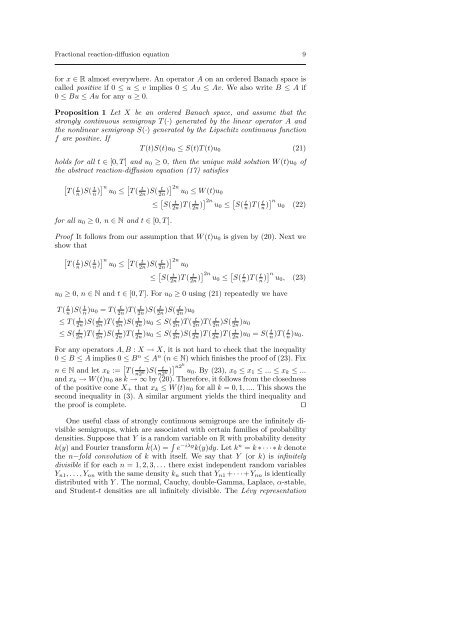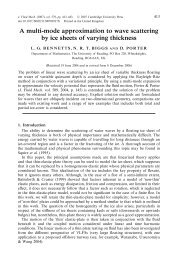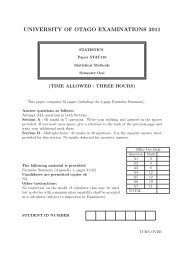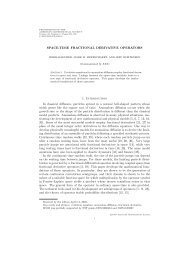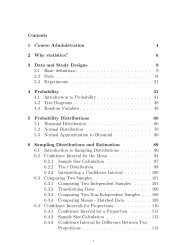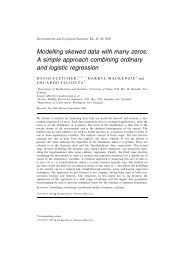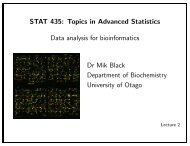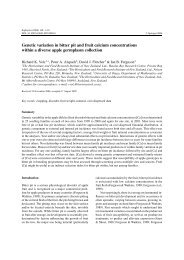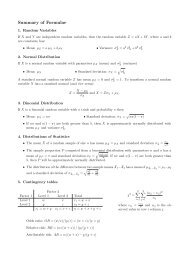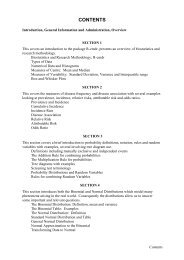Fractional reaction-diffusion equation for species ... - ResearchGate
Fractional reaction-diffusion equation for species ... - ResearchGate
Fractional reaction-diffusion equation for species ... - ResearchGate
You also want an ePaper? Increase the reach of your titles
YUMPU automatically turns print PDFs into web optimized ePapers that Google loves.
<strong>Fractional</strong> <strong>reaction</strong>-<strong>diffusion</strong> <strong>equation</strong> 9<br />
<strong>for</strong> x ∈ R almost everywhere. An operator A on an ordered Banach space is<br />
called positive if 0 ≤ u ≤ v implies 0 ≤ Au ≤ Av. We also write B ≤ A if<br />
0 ≤ Bu ≤ Au <strong>for</strong> any u ≥ 0.<br />
Proposition 1 Let X be an ordered Banach space, and assume that the<br />
strongly continuous semigroup T (·) generated by the linear operator A and<br />
the nonlinear semigroup S(·) generated by the Lipschitz continuous function<br />
f are positive. If<br />
T (t)S(t)u 0 ≤ S(t)T (t)u 0 (21)<br />
holds <strong>for</strong> all t ∈ [0, T ] and u 0 ≥ 0, then the unique mild solution W (t)u 0 of<br />
the abstract <strong>reaction</strong>-<strong>diffusion</strong> <strong>equation</strong> (17) satisfies<br />
[<br />
T (<br />
t<br />
n )S( t n )] n<br />
u0 ≤ [ T ( t<br />
2n )S( t<br />
2n )] 2n<br />
u0 ≤ W (t)u 0<br />
<strong>for</strong> all u 0 ≥ 0, n ∈ N and t ∈ [0, T ].<br />
≤ [ S( t<br />
2n )T ( t<br />
2n )] 2n<br />
u0 ≤ [ S( t n )T ( t n )] n<br />
u0 (22)<br />
Proof It follows from our assumption that W (t)u 0 is given by (20). Next we<br />
show that<br />
[<br />
T (<br />
t<br />
n )S( t n )] n<br />
u0 ≤ [ T ( t<br />
2n )S( t<br />
2n )] 2n<br />
u0<br />
≤ [ S( t<br />
2n )T ( t<br />
2n )] 2n<br />
u0 ≤ [ S( t n )T ( t n )] n<br />
u0 , (23)<br />
u 0 ≥ 0, n ∈ N and t ∈ [0, T ]. For u 0 ≥ 0 using (21) repeatedly we have<br />
T ( t n )S( t n )u 0 = T ( t<br />
2n )T ( t<br />
2n )S( t<br />
2n )S( t<br />
2n )u 0<br />
≤ T ( t<br />
2n )S( t<br />
2n )T ( t<br />
2n )S( t<br />
2n )u 0 ≤ S( t<br />
2n )T ( t<br />
2n )T ( t<br />
2n )S( t<br />
2n )u 0<br />
≤ S( t<br />
2n )T ( t<br />
2n )S( t<br />
2n )T ( t<br />
2n )u 0 ≤ S( t<br />
2n )S( t<br />
2n )T ( t<br />
2n )T ( t<br />
2n )u 0 = S( t n )T ( t n )u 0.<br />
For any operators A, B : X → X, it is not hard to check that the inequality<br />
0 ≤ B ≤ A implies 0 ≤ B n ≤ A n (n ∈ N) which finishes the proof of (23). Fix<br />
n ∈ N and let x k := [ T ( t )S( t ) ] n2 k u<br />
n2 k n2 k 0 . By (23), x 0 ≤ x 1 ≤ ... ≤ x k ≤ ...<br />
and x k → W (t)u 0 as k → ∞ by (20). There<strong>for</strong>e, it follows from the closedness<br />
of the positive cone X + that x k ≤ W (t)u 0 <strong>for</strong> all k = 0, 1, .... This shows the<br />
second inequality in (3). A similar argument yields the third inequality and<br />
the proof is complete.<br />
⊓⊔<br />
One useful class of strongly continuous semigroups are the infinitely divisible<br />
semigroups, which are associated with certain families of probability<br />
densities. Suppose that Y is a random variable on R with probability density<br />
k(y) and Fourier trans<strong>for</strong>m ˆk(λ) = ∫ e −iλy k(y)dy. Let k n = k ∗ · · · ∗ k denote<br />
the n−fold convolution of k with itself. We say that Y (or k) is infinitely<br />
divisible if <strong>for</strong> each n = 1, 2, 3, . . . there exist independent random variables<br />
Y n1 , . . . , Y nn with the same density k n such that Y n1 + · · · + Y nn is identically<br />
distributed with Y . The normal, Cauchy, double-Gamma, Laplace, α-stable,<br />
and Student-t densities are all infinitely divisible. The Lévy representation


